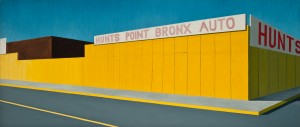
Emilio Sanchez made his first trek down Hunts Point’s Food Center Drive in 1988, when he was 67, to an art gallery in the caverns of the Krasdale Foods complex where his art was being shown.
His friend Sig Balka, general attorney for Krasdale and art connoisseur, was showing Sanchez’s work in the gallery he runs, a hidden art enclave across from the Hunts Point Meat Market.
Passing through the urban landscape of the commercial and industrial district, Sanchez was struck by what he saw.
Over the next few years, he returned often, camera in hand, to snap photos that would become the basis for nearly a hundred works, a Caribbean-flavored catalogue of South Bronx commerce. He captured the industrial drab of the neighborhood in a bright and idyllic way, revealing life behind the dingy walls.
Now, some of his works are being shown in an exhibition called Urban Archives: Emilio Sanchez in the Bronx, at the Bronx Museum of the Arts. Eight pieces will be on display until September, when the full show opens.
In all, 27 oils, watercolors, and drawings, as well as photographs from the museum’s permanent collection, will be shown. The architectural portraits portray commercial and industrial buildings with clean lines, harsh shadows, and stark perspective.
“He was inspired by the area,” said Balka, who had become friends with Sanchez through mutual artistic interests. “And he felt related to the people of a similar Hispanic origin.”
Hunts Point was not the artist’s only South Bronx stomping ground. Some of his paintings also reflect his interest in Mott Haven. One painting depicts a deli at the corner of Lincoln Ave and 136th St. The green awning shown in the piece is long gone, as are the former owners, where a bodega now stands.
Sanchez was born in Cuba in 1921, and received his primary education in boarding schools around the United States. In 1944 he came to the city to study at the Art Students League, and stayed until his death in 1999.
“This period in the late eighties he seems to have devoted to the Bronx,” said Ann Koll, executive director of the Emilio Sanchez Foundation in Manhattan. The foundation donated a selection of works to the museum earlier this year.
“I love the educational value of his work,” said Sergio Bessa, program director at the Bronx Museum. “It’s simple, clean, and dramatic.”
Bessa plans to bring students from South Bronx schools to the exhibition later this year.
A video by artist Laura Napier showing some of the buildings Sanchez portrayed in his paintings, along with an interpretation of his works, will also be shown.
“You can see that Sanchez reconstructs the buildings,” said Napier. “He didn’t just paint the photos.”
To supplement the artwork, teens from the museum’s summer youth program are producing audio podcasts of interviews they conducted with people from Hunts Point.
“It’s nice to see his interpretation of the Bronx,” said Elliott Harris, 15, a participant in the youth program. “It’s not the way the media portrays it.”
Alfred Rivera, who moved to Hunts Point with his family when he was three in 1945, remembers when the triangular building on the corner of Hunts Point Avenue and Faile Street was a pickle factory. “I remember stealing one or two when we’d pass by as kids,” he said.
Rivera, who bought the building in 1971 for $25,000, opened the liquor store seen on the corner in Sanchez’s painting. “I’d recognize it in a heartbeat,” he said. “That’s my color, I picked the red because I thought it’d attract attention.”
Tony Serrano works across the street from the yellow-walled Auto Parts yard depicted by one of Sanchez’s paintings. The yard is still there, on Hunts Point and Randall Avenues, but the wall is no longer yellow.
“I was here when it was the worst,” said Serrano, looking at a print of the painting and thinking back on his 40 years in Hunts Point. “I need to see this, it makes me proud to still be here,” he said.
“It really jumps at you,” said Trudy Sanchez, a Hunts Point resident who came to the neighborhood in 1957. “I love the vibrant colors, the brightness,” she said, leaning over the counter of MOgridder’s BBQ truck, where she works.
“His work encompassed his spirit,” said Balka. “It was flamboyant but restrained.”
“It’s an industrial setting viewed through an optimistic lens,” said Bessa. “Not the color pallet you expect.

[…] And the August 2011 print edition of The Mot Haven Herald […]